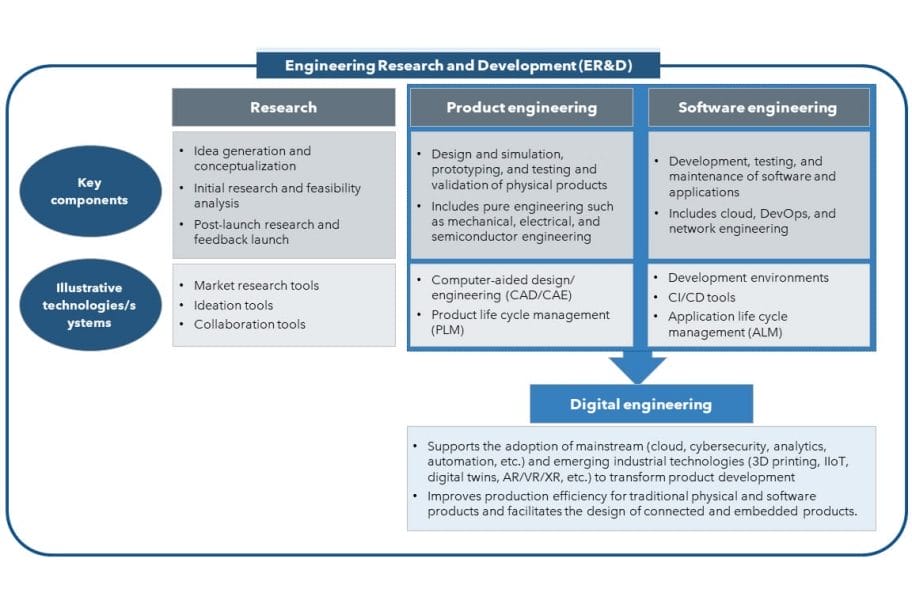Traditionally, physical and digital products were simpler and standalone, with very little to no intersection among them. Hence, traditional engineering research and development (ER&D) and manufacturing companies were focused on leveraging established engineering principles and techniques to design and develop standalone physical products (such as electrical and mechanical products). On the other hand, software development companies were focused on building digital products (such as software and applications). There were very few synergies between the traditional ER&D and software development companies.
Even in the service provider ecosystem, there used to be specialist players with product engineering capabilities (pure engineering, such as mechanical engineering and semiconductor engineering) and specialist players with software engineering capabilities (such as software and application design and development). Hence, the service providers offering engineering services treated product engineering as distinct from software engineering.
The above state of the ER&D ecosystem has rapidly changed over the past several years.
Product and Software Engineering Now Need to Converge
Of late, both B2B and B2C products have become smarter and more connected, requiring real-time integration and interaction between the hardware and software components. Such connected and digital-heavy products require complex design and engineering capabilities with parallel support from both product and software engineering teams.
Further, growing competition and macroeconomic factors such as inflation are necessitating enterprises to focus on production costs, process efficiencies, time-to-market, and differentiating metrics such as worker safety, sustainability, and customer-centricity. Enterprises can no longer adapt to the evolving ER&D demands only by adopting advanced operational technology (OT) systems for critical components in their production cycle. Rather, they need to digitalize and integrate end-to-end design and production value chains throughout their production network.
To develop connected products and digitize the engineering and manufacturing life cycle, enterprises need an amalgamation of product and software engineering capabilities.
Digital Engineering Enables Convergence of Product and Software Engineering
Digital engineering ties product engineering and software engineering together to help enterprises scale the adoption of mainstream digital and emerging industrial technologies to build a digital thread across their production life cycle and facilitate end-to-end design and development of connected products.

Digital engineering helps enterprises:
-
- Build a digital thread across the IT and the OT environment: Through combined software and hardware expertise and integration of technologies such as analytics, automation, and IoT, enterprises are automating real-time integration and data flow across ERP, manufacturing execution systems, supervisory and control systems, logic controllers, and shop floor machines and sensors.
- Improve process efficiency through technology adoption: Organizations are scaling up the adoption of mainstream digital technologies (such as cloud, cybersecurity, analytics, AI, and automation) and emerging industrial technologies (such as AR/VR/XR, digital twin, and 3D printing) to solve industrial use cases, ranging from predictive maintenance, asset and plant health monitoring, worker safety, to resource consumption tracking.
- Design new-age, connected products: By establishing synergies between the hardware and software products, enterprises are building embedded and connected products such as autonomous vehicles, connected wearables, smart home devices, and renewable energy systems.
Who is a True Digital Engineering Partner?
While digital engineering is a growing domain, it is crucial that the ecosystem players, especially engineering and manufacturing enterprises, get the essence of digital engineering right to realize its true potential.
Enterprises and service providers must understand that focusing solely on software engineering, including platform development, app modernization, network management, and new-age technology adoption, will not enable them to fulfill the end-to-end needs of developing new-age products and building an edge in this domain. Traditional product (pure) engineering capabilities are equally essential for building new-age products and adapting to the emerging ER&D function.
Hence, service providers who can parallelly bring both product and software engineering capabilities to the table have an edge in helping enterprises reap the true benefits of digital engineering. A true digital engineering partner should essentially help businesses improve their existing design and production processes through IT and OT convergence and make their products smarter.
By Shwetank Saini, Associate Research Director, Avasant, and Ritika Nijhawan, Senior Research Analyst, Avasant





